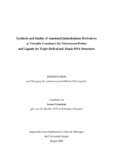Citation link:
https://nbn-resolving.org/urn:nbn:de:hbz:467-2403Files in This Item:
| File | Description | Size | Format | |
|---|---|---|---|---|
| granzhan.pdf | 4.77 MB | Adobe PDF |  View/Open |
| Dokument Type: | Doctoral Thesis | metadata.dc.title: | Synthesis and studies of annelated quinolizinium derivatives as versatile constructs for fluorescent probes and ligands for triple-helical and abasic DNA structures | Authors: | Granzhan, Anton | Institute: | Fachbereich 8, Chemie - Biologie | Free keywords: | nitrogen heterocycles, fluorescent probes, detection of biomacromolecules | Dewey Decimal Classification: | 540 Chemie | GHBS-Clases: | UWN | Issue Date: | 2006 | Publish Date: | 2006 | Abstract: | In the present Thesis, various annelated derivatives of the quinolizinium ion, i.e. polycyclic compounds with a bridgehead quaternary nitrogen atom, were synthesized and investigated as fluorescent probes for the detection of biomacromolecules and as ligands for triple-helical DNA and abasic DNA structures. Along these lines, 9-donor-substituted acridizinium (benzo[ b ]- quinolizinium) derivatives represent a versatile construct for the development of fluorescent probes. Especially promising are the substituted N -aryl-9-aminoacridizinium salts, the fluorescence of which is susceptible to the microviscosity of the medium. Such compounds may be used for the fluorimetric detection of biomacromolecules, like DNA and proteins. A series of unsubstituted and methyl-substituted diazoniapenthaphenes, as well as the isomeric diazoniaanthra[1,2- α ]anthracenes and diazoniahexaphene were prepared by the cyclodehydration synthesis. These extended derivatives diazoniapolycyclic salts represent novel lead structures, in which preferential, high-affinity binding to the triple-helical DNA may be achieved in the absence of an additional alkaline side chains. Two isomeric acridizinium-adenine conjugates, as well as three acridizinium-9-carboxamides, were prepared. Their affinity towards regular and abasic-site containing DNA structures was investigated by thermal denaturation experiments with synthetic oligodeoxyribonucleotides. Acridizinium- adenine conjugates and aminoalkyl-substituted acridizinium-9-carboxamides are capable of selective binding to abasic DNA sites. They readily induce the photo-damage of plasmid DNA, however, without selectivity towards abasic DNA structures. Im Rahmen dieser Arbeit wurden verschiedene Chinoliziniumderivate, d.h. polycyclische Aromaten, die über ein quartäres Stickstoffatom verfügen, synthetisiert und sowohl auf ihre Eignung als Fluoreszenzsensoren zur Detektion von Biomakromolekülen als auch auf ihre Bindungseigenschaften gegenüber Triplex-DNA und DNA mit abasischen Positionen hin überprüft. Zum einen wurde gezeigt, dass Derivate des Acridizinium- (Benzo[ b ]quinolizinium)-Ions, die in Position 9 einen Donorsubstituenten besitzen, ein viel versprechendes Grundgerüst für die Entwicklung von Fluoreszenzsensoren darstellen. Insbesondere die substituierten N -Aryl-9- aminoacridiziniumsalze erscheinen aussichtsreich, da deren Fluoreszenz besonders empfindlich auf kleinste Veränderungen der Viskosität des umgebenden Mediums reagiert. Eine Reihe von unsubstituierten und methylsubstituierten Diazoniapentaphen-Derivaten sowie die isomeren Diazoniaanthra[1,2- α ]anthracene und das Diazoniahexaphen wurden durch Cyclodehydratisierung erhalten. Diese polycyclische Diazoniasalze repräsentieren neue Leitstrukturen, die mit hoher Affinität eine selektive Bindung an Triplex-DNA aufweisen, ohne dass zusätzliche Aminoalkylseitenketten notwendig sind. Zwei isomere Acridizinium-Adenin-Konjugate sowie drei Modellverbindungen, d.h. Acridizinium- 9-carboxamidderivate, wurden ausgehend von den entsprechenden Carboxyacridiziniumsalzen erhalten. Ihre Bindungsaffnität gegenüber DNA, die entweder eine oder keine abasische Stelle aufweist, wurde mit Hilfe von DNA-Schmelzexperimenten mit synthetischen Oligonukleotiden ermittelt. Acridizinium-Adenin-Konjugate und aminoalkylsubstituierte Acridiziniumcarboxamide sind in der Lage, an abasische Positionen in DNA zu binden. Sie konnen die Photoschädigung von Plasmid-DNA auslosen, jedoch gibt es keine selektive Schädigung von DNA mit abasischen Positionen. |
URN: | urn:nbn:de:hbz:467-2403 | URI: | https://dspace.ub.uni-siegen.de/handle/ubsi/240 | License: | https://dspace.ub.uni-siegen.de/static/license.txt |
| Appears in Collections: | Hochschulschriften |
This item is protected by original copyright |
Page view(s)
364
checked on Nov 25, 2024
Download(s)
205
checked on Nov 25, 2024
Google ScholarTM
Check
Items in DSpace are protected by copyright, with all rights reserved, unless otherwise indicated.

